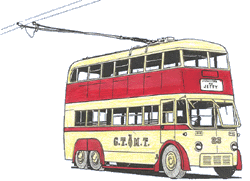 |
London Trolleybuses exported to Penang |

Click on any thumbnail for a larger image but wait until all thumbnails have downloaded
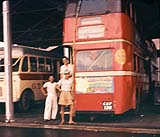 |
Picture 825 - Ex London #138 [GTMT #24]
Picture of the rear of 138 taken by Derek Watts [while conscripted
to Singapore] which also shows an RAF mate, plus some natives grinning nicely. This picture and another below
are from a 2¼ square transparencies electronically restored using Photoshop.
Sadly this picture has noticeable camera shake.
 Picture of vehicle in service at Ayer Itam.
Picture of vehicle in service at Ayer Itam. |
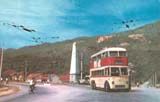 |
Picture 826 - Ex London #142 [GTMT #20]
Taken at Ayer Itam, an outer suburb of Georgetown Penang. This area is well known for postcard photos because of
the World War II memorial, also the junction to the Hills Railway. |
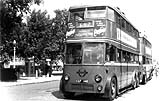 |
Picture 827 - Ex London #148 [GTMT #21]
[From a picture by A.M.Wright]
Shepherds Bush Green at the terminal point on the South Side of the Green at the eastern end, facing westwards.
 Picture of vehicle in service in Penang.
Picture of vehicle in service in Penang. |
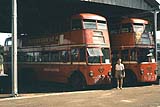 |
Picture 828 - Ex London #175 [GTMT #22]
Three LTE trolleybuses still in London livery at the depot in 1956 with 175 on the left, 183 on the right and the
back end of 138 in view behind 183. That's Derek Watts cluttering up the front.
With acknowledgements to
Derek Watts. |
 |
Picture 829 - Ex London #183 [GTMT #23]
Pictured shortly after delivery, and is seen in the livery of Penang Georgetown Municipal Transport with a fleet
number of 23.
 Another picture of this vehicle in service in Penang.
Another picture of this vehicle in service in Penang. |
Acknowledgements to
"David Jones" <ddjones@paradise.net.nz>
for permission to use the line drawing at the head of this page
 Information on Penang's trolleybuses
was extracted on 2 March 2004 from
Information on Penang's trolleybuses
was extracted on 2 March 2004 from
KNEWSTUBB'S TROLLEYBUS WORLD GAZETTE web site
[Site URL: www.tbus.bravepages.com/index.html]

From: "Ric Francis" <tram1@dodo.com.au>
The new Transport board had decided as an experiment to purchase five ex-London transport double-deckers in 1956.
The vehicles themselves had been some of the oldest working for London Transport when withdrawn by them in 1955. They were ex-C1
class AEC vehicles and arrived at the quayside in May and June 1956. Having seen already 20 years service they could be said to be a
curious choice, but they had been well maintained by their former owners and were, even taking into account shipping charges, rather
inexpensive.
Given the random order of the numbers it can be assumed that they were members of the class in best condition and in fact whilst four
had Metro-Cammell bodies, the fifth had a body built by Weymann.
They became No's. 20 to 24 with Georgetown Municipal Transport, taking the numbers formerly allocated to pre-war Ransomes trolleybuses.
They were numbered in chassis number order and their previous London Transport fleet numbers had been 142, 148, 175, 183 and 138
respectively. When new they were used on routes 657, from Isleworth Depot and 667 from Fulwell Depot and had been replaced in 1952
by 70 seat BUT 9641s the last ever London trolleybuses to be delivered - Nos.1842 to 1891. In 1952 the C1 class were transferred to
Highgate (Holloway) depot to replace 60 seat B2 class trolleybuses and for their last three years in service had been kept to the relatively
quiet "Hampstead Routes" i.e. 513, 613, 615 and 639. At the time many London trolleybuses were being withdrawn due to
service cuts and these "lucky" five were the only pre-war trolleybuses to be sold for further use and thereby avoid the
cutters torch.
On arrival they were towed to the depot for certain modifications. Ventilation for example was inadequate, and the solution was to fix full
drop depth sliding windows. The existing seating was unsuitable as it encouraged cockroaches so standard tropical materials were
fitted. They were also fitted with automatic acceleration. Initially the rear registration plate displayed the fleet number in red and the fleet
number was also displayed centrally on the front panel.
Staff had to be consulted as to the manning of these "giants" and conducting staff would only work on them
on the principle of "one deck, one man". The Department went into consultation with the only other double-deck operator
G.T.C. of Kuala Lumpur. They used this system and found that the extra revenue earned by their double-deck vehicles more than
paid for the extra man's wages. It would seem that the lower deck man held seniority and to him fell the honourable tasks of
replacing poles, pulling over junction frogs and being in charge of the platform.
Initially it is believed that these vehicles worked the Jelutong route. The only difficulty was at the town end of the route at the Jetty,
where these longer vehicles were unable to negotiate the turning circle without reversing. Extensive road works were put in hand
and the circle enlarged. In theory they could operate on all routes except the Hill Railway shuttle and photographic evidence would
suggest that fairly soon after entering service they more often than not worked the Ayer Itam route.
Initially they apparently "gave a good account for themselves". This may have been almost a honeymoon period
as with three crew members on board, despite Kuala Lumpur experience, with relatively low fare levels they soon became
uneconomic. Their age must also have told against them and one can only assume that they were purchased basically to
assess double-deck operation, whether it be trolleybus or motor bus.

![]()





![]() Information on Penang's trolleybuses
was extracted on 2 March 2004 from
Information on Penang's trolleybuses
was extracted on 2 March 2004 from ![]()